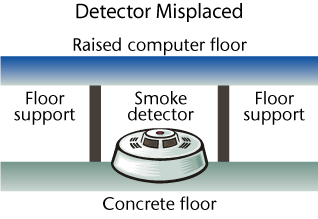Don't Get Burned By Fire
Protecting lives is the most important function that security dealers perform. To properly design and install systems that will detect fires and provide notification locally and remotely, you must possess an in-depth knowledge of the detectors available and the correct installation procedures. If you lack these essential skills, you can be putting your customers’ lives and your business in jeopardy every time you work on a fire alarm system. To see how your fire detection knowledge stacks up, take the following quiz.1. Ionization-type smoke detectors respond faster to slow smoldering fires than photoelectric detectors respond.
a. True
b. False
2. The difference between the operating temperature of a device and the actual air temperature is called:
a. rate compensated.
b. rate of rise.
c. thermal lag.
d. None of the above
3. To reset a nonrestorable heat detector, you must:
a. momentarily remove power.
b. manually press the reset.
c. lower the temperature of the device.
d. Any of the above
e. None of the above
4. What does the word “shall†indicate when reading NFPA 72?
a. A recommended action
b. A mandatory requirement
c. A generally accepted practice
d. None of the above
5. “T†tapping of nonaddressable initiating devices is not permitted.
a. True
b. False
6. Manual fire alarm pull stations shall be located how many feet from a doorway?
a. 1
b. 5
c. 10
d. 15
e. Any of the above
7. Vane-type water flow detectors are commonly used on dry sprinkler systems.
a. True
b. False
8. All approved manual fire alarm pull stations are single-action.
a. True
b. False
9. A sprinkler system valve that is below ground level with an actuator and indicator located above ground is called a:
a. butterfly valve.
b. OS&Y.
c. PIV.
d. None of the above
10. Heat detector spacing is reduced when the ceiling height exceeds 10 feet.
a. True
b. False
11. Unless specifically designed for the condition, smoke detectors shall not be installed if the:
a. temperature is below 32 F or above 100 F.
b. relative humidity is above 93 percent.
c. air velocity is greater than 300 feet per minute.
d. Any of the above
e. None of the above
12. Manual pull stations shall be installed so that the actuator is between 3-1/2 and 4-1/2 feet above the floor.
a. True
b. False
13. Which of the following NFPA standards covers wiring requirements?
a. 13
b. 70
c. 72
d. 101
None of the above

What’s Wrong with This?
As part of a fire alarm system that included total smoke detection coverage, Wally `Larman installed smoke detectors below a solid-tile, raised computer room floor. Wally properly spaced the detectors and installed each as shown in this diagram. When Wally tested the system, each detector activated properly, but when the local fire marshal performed his inspection, Wally got a failing grade. Can you see what Wally did wrong and what he must do to correct the problem?5-Minute Tech Quiz Answers
1. b2. c
3. e – A nonrestorable device cannot be reset because it is destroyed when activated. An example is a fusible link.
4. b – “Shall†indicates a code requirement. “Should†is a code recommendation.
5. a – “T†tapping of nonaddressable or traditional devices is not allowed, because that practice does not provide complete supervision of all cabling, connections and devices. It may be allowable for some addressable devices, because supervision is achieved by the unique address of each module and the control’s polling scheme.
6. b
7. b – Vane-type water flow switches are used on wet sprinkler systems. Dry systems use pressure switches to detect water flow.
8. b
9. c
10. a – According to NFPA 72 2002 table 5.6.5.5.1, heat detector spacing is reduced on ceiling heights that exceed 10 feet.
11. d
12. a
13. b – The National Electric Code NFPA 70 covers wiring requirements. NFPA 13 is the standard for sprinkler systems, NFPA 72 is the National Fire Alarm Code and NFPA 101 is the life safety code.



